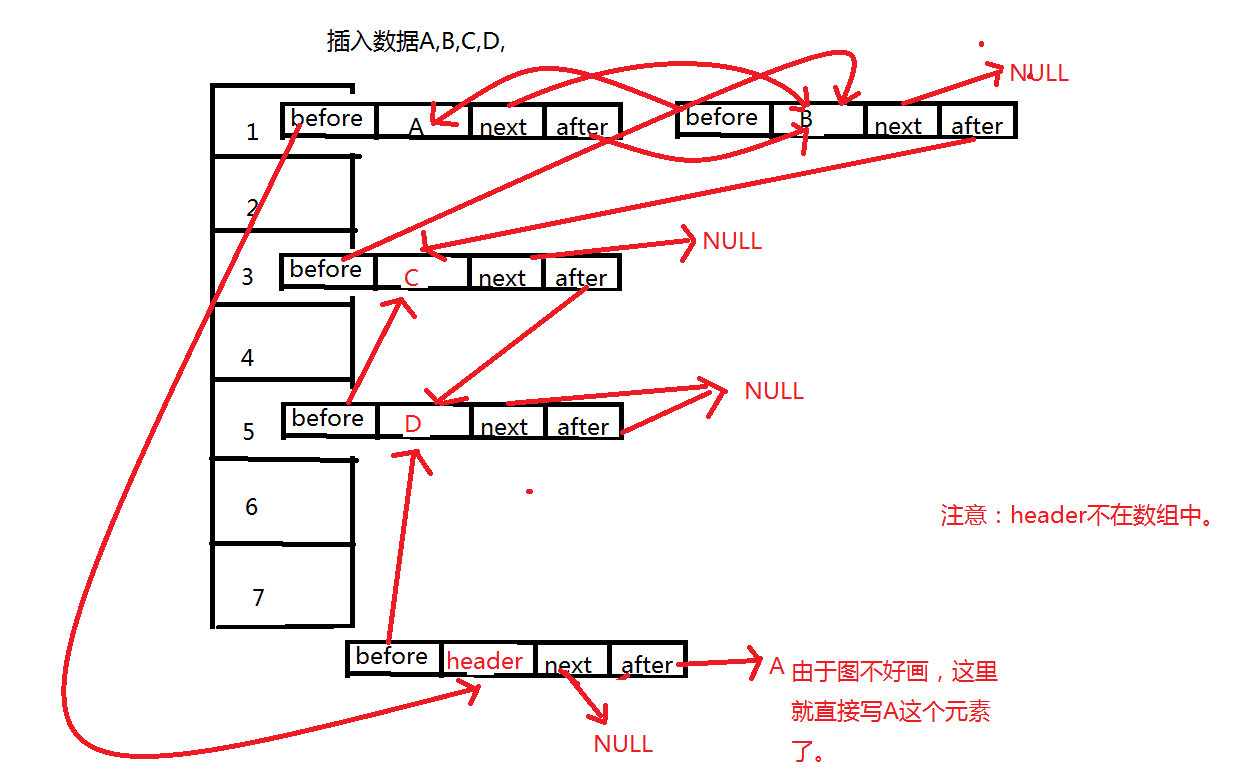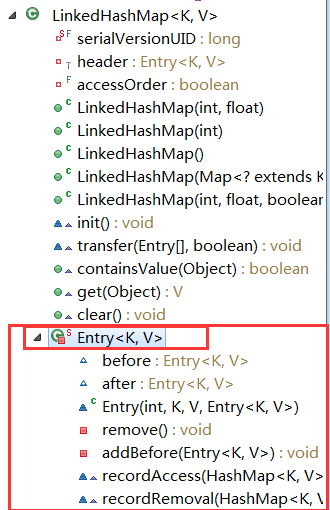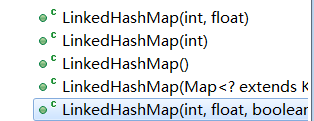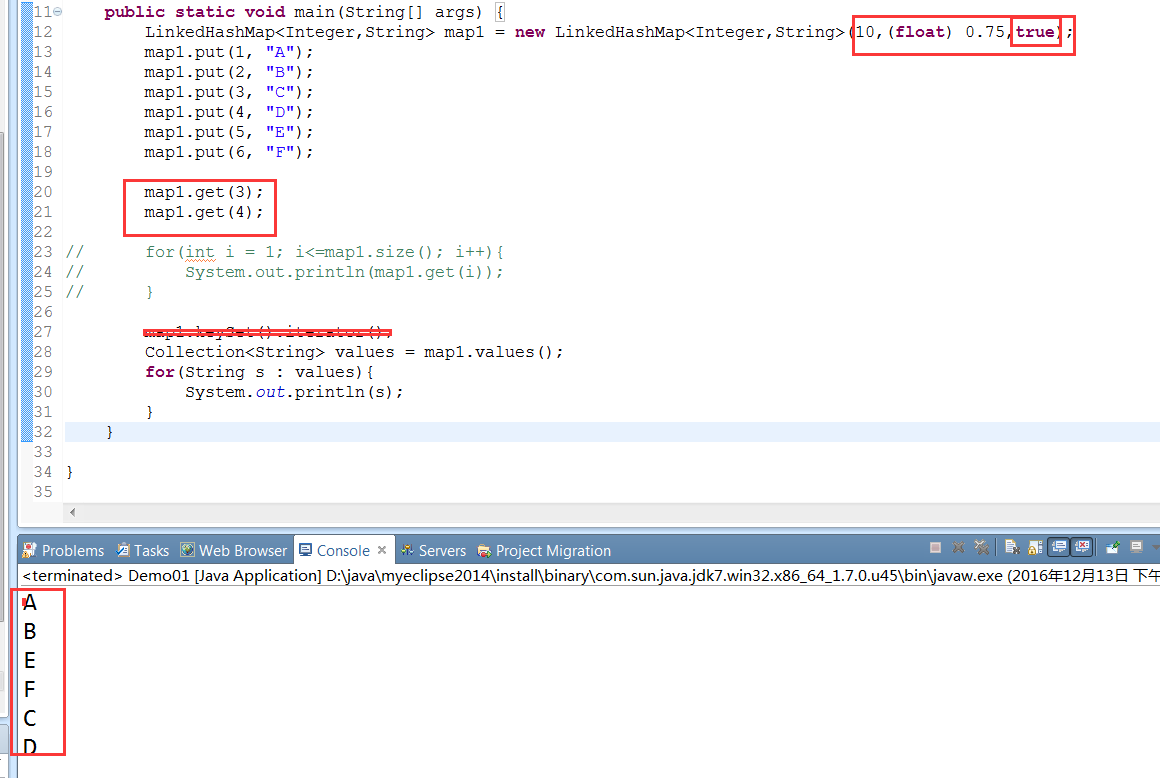序言
本来是不打算先讲map的,但是随着对set集合的认识,发现如果不先搞懂各种map,是无法理解set的。因为set集合很多的底层就是用map来存储的。比如HashSet就是用HashMap,LinkedHashSet就是用LinkedHashMap。所以打算把map讲完把。
---WZY
一、LinkedHashMap
先来说说它的特点,然后在一一通过分析源码来验证其实现原理
1、能够保证插入元素的顺序。深入一点讲,有两种迭代元素的方式,一种是按照插入元素时的顺序迭代,比如,插入A,B,C,那么迭代也是A,B,C,另一种是按照访问顺序,比如,在迭代前,访问了B,那么迭代的顺序就是A,C,B,比如在迭代前,访问了B,接着又访问了A,那么迭代顺序为C,B,A,比如,在迭代前访问了B,接着又访问了B,然后在访问了A,迭代顺序还是C,B,A。要说明的意思就是不是近期访问的次数最多,就放最后面迭代,而是看迭代前被访问的时间长短决定。
3、内部存储的元素的模型。entry是下面这样的,相比HashMap,多了两个属性,一个before,一个after。next和after有时候会指向同一个entry,有时候next指向null,而after指向entry。这个具体后面分析。

4、linkedHashMap和HashMap在存储操作上是一样的,但是LinkedHashMap多的东西是会记住在此之前插入的元素,这些元素不一定是在一个桶中,画个图。

也就是说,对于linkedHashMap的基本操作还是和HashMap一样,在其上面加了两个属性,也就是为了记录前一个插入的元素和记录后一个插入的元素。也就是只要和hashmap一样进行操作之后把这两个属性的值设置好,就OK了。注意一点,会有一个header的实体,目的是为了记录第一个插入的元素是谁,在遍历的时候能够找到第一个元素。
实际上存储的样子就像上面这个图一样,这里要分清楚哦。实际上的存储方式是和hashMap一样,但是同时增加了一个新的东西就是 双向循环链表。就是因为有了这个双向循环链表,LinkedHashMap才和HashMap不一样。
5、其他一些比如如何实现的循环双向链表,插入顺序和访问顺序如何实现的就看下面的详细讲解了。
二、源码分析
2.1、内部存储元素的存储结构源码和理解LinkedHashMap双向循环链表,

//LinkedHashMap的entry继承自HashMap的Entry。 private static class Entry<K,V> extends HashMap.Entry<K,V> { // These fields comprise the doubly linked list used for iteration. //通过上面这句源码的解释,我们可以知道这两个字段,是用来给迭代时使用的,相当于一个双向链表,实际上用的时候,操作LinkedHashMap的entry和操作HashMap的Entry是一样的,只操作相同的四个属性,这两个字段是由linkedHashMap中一些方法所操作。所以LinkedHashMap的很多方法度是直接继承自HashMap。 //before:指向前一个entry元素。after:指向后一个entry元素 Entry<K,V> before, after; //使用的是HashMap的Entry构造 Entry(int hash, K key, V value, HashMap.Entry<K,V> next) { super(hash, key, value, next); } //下面是维护这个双向循环链表的一些操作。在HashMap中没有这些操作,因为HashMap不需要维护, /** * Removes this entry from the linked list. */
//我们知道在双向循环链表时移除一个元素需要进行哪些操作把,比如有A,B,C,将B移除,那么A.next要指向c,c.before要指向A。下面就是进行这样的操作,但是会有点绕,他省略了一些东西。
//有的人会问,要是删除的是最后一个元素呢,那这个方法还适用吗?有这个疑问的人应该注意一下这个是双向循环链表,双向,删除哪个度适用。 private void remove() {
//this.before.after = this.after;
//this.after.before = this.before; 这样看可能会更好理解,this指的就是要删除的哪个元素。
before.after = after; after.before = before; } /** * Inserts this entry before the specified existing entry in the list. */
//插入一个元素之后做的一些操作,就是将第一个元素,和最后一个元素的一些指向改变。传进来的existingEntry就是header。
private void addBefore(Entry<K,V> existingEntry) { after = existingEntry; before = existingEntry.before; before.after = this; after.before = this; } /** * This method is invoked by the superclass whenever the value * of a pre-existing entry is read by Map.get or modified by Map.set. * If the enclosing Map is access-ordered, it moves the entry * to the end of the list; otherwise, it does nothing. */
//这个方法就是我们一开始说的,accessOrder为true时,就是使用的访问顺序,访问次数最少到访问次数最多,此时要做特殊处理。处理机制就是访问了一次,就将自己往后移一位,这里就是先将自己删除了,然后在把自己添加,
//这样,近期访问的少的就在链表的开始,最近访问的元素就会在链表的末尾。如果为false。那么默认就是插入顺序,直接通过链表的特点就能依次找到插入元素,不用做特殊处理。
void recordAccess(HashMap<K,V> m) { LinkedHashMap<K,V> lm = (LinkedHashMap<K,V>)m; if (lm.accessOrder) { lm.modCount++; remove(); addBefore(lm.header); } } void recordRemoval(HashMap<K,V> m) { remove(); } }
通过查看LinkedHashMap的entry,就验证了我们上面说的特性3.
2.2、构造方法
有五个构造方法。

1 //使用父类中的构造,初始化容量和加载因子,该初始化容量是指数组大小。
2 public LinkedHashMap(int initialCapacity, float loadFactor) {
3 super(initialCapacity, loadFactor);
4 accessOrder = false;
5 }
6 //一个参数的构造
7 public LinkedHashMap(int initialCapacity) {
8 super(initialCapacity);
9 accessOrder = false;
10 }
11 //无参构造
12 public LinkedHashMap() {
13 super();
14 accessOrder = false;
15 }
16 //这个不用多说,用来接受map类型的值转换为LinkedHashMap
17 public LinkedHashMap(Map<? extends K, ? extends V> m) {
18 super(m);
19 accessOrder = false;
20 }
21 //真正有点特殊的就是这个,多了一个参数accessOrder。存储顺序,LinkedHashMap关键的参数之一就在这个,
//true:指定迭代的顺序是按照访问顺序(近期访问最少到近期访问最多的元素)来迭代的。 false:指定迭代的顺序是按照插入顺序迭代,也就是通过插入元素的顺序来迭代所有元素
//如果你想指定访问顺序,那么就只能使用该构造方法,其他三个构造方法默认使用插入顺序。
22 public LinkedHashMap(int initialCapacity,
23 float loadFactor,
24 boolean accessOrder) {
25 super(initialCapacity, loadFactor);
26 this.accessOrder = accessOrder;
27 }
2.3、验证header的存在
//linkedHashMap中的init()方法,就使用header,hash值为-1,其他度为null,也就是说这个header不放在数组中,就是用来指示开始元素和标志结束元素的。 void init() { header = new Entry<>(-1, null, null, null); //一开始是自己指向自己,没有任何元素。HashMap中也有init()方法是个空的,所以这里的init()方法就是为LinkedHashMap而写的。 header.before = header.after = header; } //在HashMap的构造方法中就会使用到init(), public HashMap(int initialCapacity, float loadFactor) { if (initialCapacity < 0) throw new IllegalArgumentException("Illegal initial capacity: " + initialCapacity); if (initialCapacity > MAXIMUM_CAPACITY) initialCapacity = MAXIMUM_CAPACITY; if (loadFactor <= 0 || Float.isNaN(loadFactor)) throw new IllegalArgumentException("Illegal load factor: " + loadFactor); this.loadFactor = loadFactor; threshold = initialCapacity; init(); }
2.4、LinkedHashMap是如何和其父类HashMap共享一些方法的。比如,put操作等。
1、LinkedHashMap构造方法完成后,调用put往其中添加元素,查看父类中的put源码
put
1 //这个方法应该挺熟悉的,如果看了HashMap的解析的话 2 public V put(K key, V value) { 3 //刚开始其存储空间啥也没有,在这里初始化 4 if (table == EMPTY_TABLE) { 5 inflateTable(threshold); 6 } 7 //key为null的情况 8 if (key == null) 9 return putForNullKey(value); 10 //通过key算hash,进而算出在数组中的位置,也就是在第几个桶中 11 int hash = hash(key); 12 int i = indexFor(hash, table.length); 13 //查看桶中是否有相同的key值,如果有就直接用新植替换旧值,而不用在创建新的entry了 14 for (Entry<K,V> e = table[i]; e != null; e = e.next) { 15 Object k; 16 if (e.hash == hash && ((k = e.key) == key || key.equals(k))) { 17 V oldValue = e.value; 18 e.value = value; 19 e.recordAccess(this); 20 return oldValue; 21 } 22 } 23 24 modCount++; 25 //上面度是熟悉的东西,最重要的地方来了,就是这个方法,LinkedHashMap执行到这里,addEntry()方法不会执行HashMap中的方法,而是执行自己类中的addEntry方法,这里就要
提一下LinkedHashMap重写HashMap中两个个关键的方法了。看下面的分析。 26 addEntry(hash, key, value, i); 27 return null; 28 }
重写了void addEntry(int hash, K key, V value, int bucketIndex) 和void createEntry(int hash, K key, V value, int bucketIndex)
//重写的addEntry。其中还是会调用父类中的addEntry方法,但是此外会增加额外的功能, void addEntry(int hash, K key, V value, int bucketIndex) { super.addEntry(hash, key, value, bucketIndex); // Remove eldest entry if instructed Entry<K,V> eldest = header.after; if (removeEldestEntry(eldest)) { removeEntryForKey(eldest.key); } } //HashMap的addEntry,就是在将元素加入桶中前判断桶中的大小或者数组的大小是否合适,总之就是做一些数组容量上的判断和hash值的问题。 void addEntry(int hash, K key, V value, int bucketIndex) { if ((size >= threshold) && (null != table[bucketIndex])) { resize(2 * table.length); hash = (null != key) ? hash(key) : 0; bucketIndex = indexFor(hash, table.length); } //这里就是真正创建entry的时候了。也被LinkedHashMap重写了。 createEntry(hash, key, value, bucketIndex); } //重写的createEntry,这里要注意的是,新元素放桶中,是放第一位,而不是往后追加,所以下面方法中前面三行应该知道了 void createEntry(int hash, K key, V value, int bucketIndex) { HashMap.Entry<K,V> old = table[bucketIndex]; Entry<K,V> e = new Entry<>(hash, key, value, old); table[bucketIndex] = e;
//这个方法的作用就是将e放在双向循环链表的末尾,需要将一些指向进行修改的操作。。 e.addBefore(header); size++; }
到这里,应该就对LinkedHashMap的存储过程有一定的了解了。并且也应该知道是如何存储的了。存储时有何特殊之处。
2.5、来看看迭代器的使用。对双向循环链表的遍历操作。但是这个迭代器是abstract的,不能直接被对象所用,但是能够间接使用,就是通过keySet().interator(),就是使用的这个迭代器
//这个也非常简单,无非就是对双向循环链表进行遍历。 private abstract class LinkedHashIterator<T> implements Iterator<T> { //先拿到header的after指向的元素,也就是第一个元素。 Entry<K,V> nextEntry = header.after; //记录前一个元素是谁,因为刚到第一个元素,第一个元素之前的元素理论上就是null。实际上是指向最后一个元素的。知道就行。 Entry<K,V> lastReturned = null; /** * The modCount value that the iterator believes that the backing * List should have. If this expectation is violated, the iterator * has detected concurrent modification. */ int expectedModCount = modCount; //判断有没有到循环链表的末尾,就看元素的下一个是不是header。 public boolean hasNext() { return nextEntry != header; } //移除操作,也就一些指向问题 public void remove() { if (lastReturned == null) throw new IllegalStateException(); if (modCount != expectedModCount) throw new ConcurrentModificationException(); LinkedHashMap.this.remove(lastReturned.key); lastReturned = null; expectedModCount = modCount; } //下一个元素。一些指向问题,度是双向循环链表中的操作。 Entry<K,V> nextEntry() { if (modCount != expectedModCount) throw new ConcurrentModificationException(); if (nextEntry == header) throw new NoSuchElementException(); Entry<K,V> e = lastReturned = nextEntry; nextEntry = e.after; return e; } }
keySet()是如何间接使用了LinkedHashIterator的
hashMap中的keySet()

找到newKeyIterator()
![]()
是LinkedHashMap对象调用的,而LinkedHashMap中重写了KeyIterator方法,所以就这样间接的使用了LinkedHashIterator迭代器

2.6、看看迭代时使用访问顺序如何实现的,其实关键也就是在哪个recordAccess方法,来看看流程
linkedHashMap中有get方法,不会使用父类中的get方法
public V get(Object key) { Entry<K,V> e = (Entry<K,V>)getEntry(key); if (e == null) return null; //关键的就是这个方法 e.recordAccess(this); return e.value; } //这个方法在上面已经分析过了,如果accessOrder为true,那么就会用访问顺序。if条件下的语句会执行,作用就是将最近访问的元素放链表的末尾。 void recordAccess(HashMap<K,V> m) { LinkedHashMap<K,V> lm = (LinkedHashMap<K,V>)m; if (lm.accessOrder) { lm.modCount++; remove(); addBefore(lm.header); } }
2.7、使用默认的插入顺序就不用多分析了,也就是上面这个if下的代码不生效,就会使用插入顺序。
三、验证LinkedHashMap的功能
注意、map是不能够只能拿到迭代器的,只能够拿到keySet().iterator(); 也就是说迭代器是不能够迭代map的,到时能够间接的使用迭代器。就比如先拿到key的迭代器,然后在通过key找到对应的value值,或者直接用values()方法,拿到所有的map的value。values()方法的底层也是使用的迭代器。
1、使用访问顺序,结果确实是如我们所预期那样

注意:如果使用for循环来遍历,肯定就不是这个结果了,原因是for循环是按照key值的顺序来查找的呀,从1到6,这里如果需要验证访问顺序,就必须使用迭代器,而map使用迭代器有两种方式,一种就是我上面所用的使values(),另一种是使用keySet().Iterator();自己可以尝试一下。
四、总结
1、知道LinkedHashMap的实现原理。
1.1、实现原理,跟HashMap一模一样。HashMap有的特性,LinkedHashMap基本上都有。
1.2、具体的存储实现,就看一开始的那两张图。虽然第二张画得比较乱,但是仔细去看,就能够弄懂其中的道理。
2、知道LinkedHashMap迭代的访问顺序和插入顺序
2.1、关键属性accessOrder
2.2、关键方法recordAccess
3、知道LinekdHashMap和HashMap的区别。
3.1、LinkedHashMap是HashMap的子类,实现的原理跟HashMap差不多,唯一的区别就是LinkedHashMap多了一个双向循环链表。
3.2、因为有双向循环列表,所以LinkedHashMap能够记录插入元素的顺序,而HashMap不能,
4、map使用迭代的两种方式,知道其内部是如何使用迭代器的。
keySet().iterator()
values()